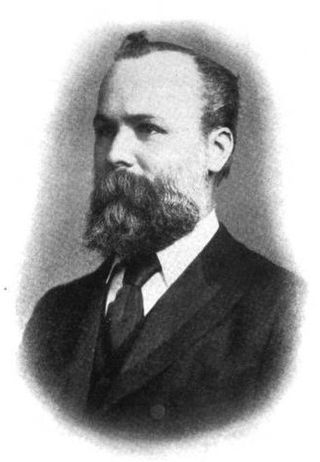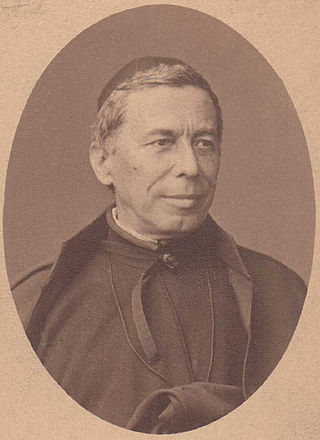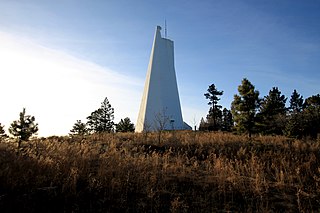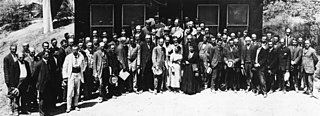Related Research Articles

The Mount Wilson Observatory (MWO) is an astronomical observatory in Los Angeles County, California, United States. The MWO is located on Mount Wilson, a 5,710-foot (1,740-meter) peak in the San Gabriel Mountains near Pasadena, northeast of Los Angeles.

Edward Walter Maunder was an English astronomer. His study of sunspots and the solar magnetic cycle led to his identification of the period from 1645 to 1715 that is now known as the Maunder Minimum.

Angelo Secchi was an Italian Catholic priest and astronomer from the Italian region of Emilia. He was director of the observatory at the Pontifical Gregorian University for 28 years. He was a pioneer in astronomical spectroscopy, and was one of the first scientists to state authoritatively that the Sun is a star.

Sunspot is an unincorporated community in the Sacramento Mountains in the Lincoln National Forest in Otero County, New Mexico, United States, about 18 miles (29 km) south of Cloudcroft. Its elevation is 9,186 feet (2,800 m). The Sunspot Solar Observatory and Apache Point Observatory are located in Sunspot in the Sacramento Mountains. The site of Sunspot is leased by the National Science Foundation (NSF) from the US Forest Service (USFS), and is operated and maintained by the Association of Universities for Research in Astronomy. The telescope and site are both open to the public, and the visitors center offers guided tours of the site on Saturdays and Sundays. On other days there is a self-guided 1/2 mile trail around the telescope and White Sands overlook.

The Wolf number is a quantity that measures the number of sunspots and groups of sunspots present on the surface of the Sun. Historically, it was only possible to detect sunspots on the far side of the Sun indirectly using helioseismology. Since 2006, NASA's STEREO spacecrafts allow their direct observation.

Anil Kumar Das FRAS, FNI was an Indian scientist, astronomer. During the International Geophysical Year, observatories in Madrid, India, and Manila were responsible for monitoring solar effects. The Kodaikanal Solar Observatory in South India performed this monitoring using their recently built solar tunnel telescope. Das was the director of the Kodaikanal observatory at this time. In 1960 he was responsible for installing a tower/tunnel telescope at the facility that would be used to perform some of the first helioseismology investigations. The crater Das on the far side of the Moon is named after him.

The Dunn Solar Telescope, also known as the Richard B. Dunn Solar Telescope, is a unique vertical-axis solar telescope that specializes in high-resolution imaging and spectroscopy. It is located at Sacramento Peak in Sunspot, New Mexico. It is the main telescope at the Sunspot Solar Observatory, operated by New Mexico State University in partnership with the National Solar Observatory through funding from the National Science Foundation, the state of New Mexico, and private funds from other partners. The Dunn Solar Telescope helps astrophysicists worldwide better understand the Sun and how it affects Earth.

A solar telescope or a solar observatory is a special-purpose telescope used to observe the Sun. Solar telescopes usually detect light with wavelengths in, or not far outside, the visible spectrum. Obsolete names for Sun telescopes include heliograph and photoheliograph.

The Algonquin Radio Observatory (ARO) is a radio observatory located in Algonquin Provincial Park in Ontario, Canada. It opened in 1959 in order to host a number of the National Research Council of Canada's (NRC) ongoing experiments in a more radio-quiet location than Ottawa.

Rocket astrophysical observatories K-2, K-3 and K-4 were launched in Soviet Union in the 1960s and early 1970s under the direction of Grigor Gurzadyan of Byurakan Observatory in Armenia, for the study of the Solar ultraviolet and X-ray emission.
Arthur Edwin Covington was a Canadian physicist who made the first radio astronomy measurements in Canada. Through these he made the valuable discovery that sunspots generate large amounts of microwaves at the 10.7 cm wavelength, offering a simple all-weather method to measure and predict sunspot activity, and their associated effects on communications. The sunspot detection program has run continuously to this day.
In solar physics and observation, an active region is a temporary feature in the Sun's atmosphere characterized by a strong and complex magnetic field. They are often associated with sunspots and are commonly the source of violent eruptions such as coronal mass ejections and solar flares. The number and location of active regions on the solar disk at any given time is dependent on the solar cycle.

The Stonyhurst Observatory is a functioning observatory and weather station at Stonyhurst College in Lancashire, England. Built in 1866, it replaced a nearby earlier building, built in 1838, which is now used as the Typographia Collegii.
Loyal Blaine Aldrich was an American astrophysicist and astronomer of the Smithsonian Institution. Upon graduation from the University of Wisconsin in 1907, Aldrich became a Smithsonian Astrophysical Observatory assistant to Charles Greeley Abbot. The observatory conducted astrophysical research on solar radiation and the amount of energy from the Sun that strikes the outer edge of the Earth's atmosphere. Abbot became director of the observatory in 1907 and established solar observing stations in the United States, South America, and Africa to carry out research on solar radiation. Aldrich became director of the observatory from 1942 to 1955. Harvard University astronomy department chairman Fred Lawrence Whipple became director of the observatory when Aldrich retired.

Aloysius Laurence Cortie was an English Jesuit astronomer. He served as director of the Stonyhurst College Observatory and contributed to the study of the Sun, including through observing solar eclipses.
Solar observation is the scientific endeavor of studying the Sun and its behavior and relation to the Earth and the remainder of the Solar System. Deliberate solar observation began thousands of years ago. That initial era of direct observation gave way to telescopes in the 1600s followed by satellites in the twentieth century.
The Sunspot Solar Observatory (SSO) is an astronomical observatory designed for the study of the Sun. The observatory is operated by New Mexico State University (NMSU) and the U.S. National Solar Observatory (NSO). It is split between operations at the telescope facility at Sunspot, New Mexico, and data and management at the Department of Astronomy at New Mexico State University. The Sunspot telescope facility is in the Sacramento Mountains, approximately 18 miles (29 km) south of Cloudcroft. Access to the facility telescopes and grounds are open for to the public for guided tours. It is funded by the National Science Foundation in partnership with the state of New Mexico.

Sunspot drawing or sunspot sketching is the act of drawing sunspots. Sunspots are darker spots on the Sun's photosphere. Their prediction is very important for radio communication because they are strongly associated with solar activity, which can seriously damage radio equipment.

The Snow Solar Telescope is a solar telescope at the Mount Wilson Observatory in California. It was originally named the Snow Horizontal Telescope as it uses a coelostat to deflect light from the Sun into a fixed horizontal shed where it can be studied. The telescope was funded by a donation from Helen E. Snow of Chicago in 1903. It was assembled at Yerkes Observatory then transferred to Mt. Wilson in 1905.
In solar observation and imaging, coordinate systems are used to identify and communicate locations on and around the Sun. The Sun is made of plasma, so there are no permanent demarcated points that can be referenced.
References
- ↑ Stonyhurst Disk Animation Archived 2010-03-10 at the Wayback Machine , Data and Activities for Solar Learning, eo.nso.edu,
- ↑ "Daily Sunspot Drawings at the 150-Foot Solar Tower", The 150-Foot Solar Tower at Mt. Wilson Observatory, UCLA